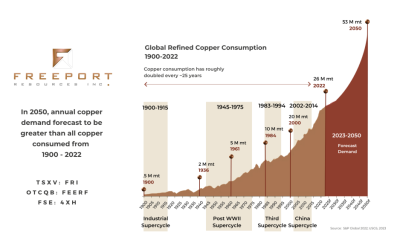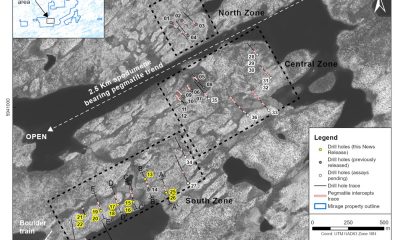Uncategorized
EV Nickel evaluates bioleaching potential for Shaw Dome, Ontario
EV Nickel Inc. [EVNI-TSXV] reported results of a technical evaluation of bioleaching application on its…

EV Nickel Inc. [EVNI-TSXV] reported results of a technical evaluation of bioleaching application on its high-grade W4 sulphide zone, located in the middle of its Shaw Dome project, just outside Timmins, northeastern Ontario. The evaluation was completed by the Research and Productivity Council (RPC) of Fredericton, New Brunswick.
RPC raised locally occurring bacteria from Shaw Dome water samples and then developed two conceptual flow sheets to process the material through a Whole Ore to Heap Bioleach and a Crushing-Grinding-Flotation to Tank Bioleach.
RPC completed initial bench scale testing which proved the ore is amenable to bioleaching and extraction rates realized for Ni and Co were very encouraging, indicating a strong bioleaching potential for W4, likely greater with Tank Bioleach. Based upon these results, RPC’s bench scale testing now enters an optimization phase.
“Confirmation that the W4 Zone is amenable to bioleaching is a big step forward for EVNI and its Clean Nickel strategy,” said Sean Samson, President & CEO. “Our objective is to rethink every stage of our business, and this is a great example of unlocking opportunity through innovation. If successful, Tank Bioleach could allow EV Nickel to skip sending concentrate to foreign-owned smelters and refiners and produce a finished product for domestic battery plants, from our site. This would have clear commercial and environmental advantage, plus develop a revolutionizing technology for mineral processing in Ontario.”
The RPC research study was completed on a sample of W4 ore with a composite grade of 0.78% nickel and 0.02% cobalt. Extractions achieved by the test work ranged from 86.0% to 90.5% for nickel and 85.2% to 90.1% for cobalt after tests ranging from 8-12 days of leaching under defined pH and temperature conditions.
The degree of sulphuric acid (H2SO4) consumption is a key consideration when assessing bioleaching potential and based upon the composition of the host ultramafic- magnesium-rich materials with low sulphide content – the Heap Bioleach scenario was determined to be problematic for the W4 ore. RPC recommended the Tank Bioleach scenario because it is expected to have a considerably lower acid consumption and by incorporating flotation to upgrade the feed it will likely result in even higher bioleaching efficiency. Plus, the Tank Bioleach scenario has a far smaller processing footprint and likely lower capital costs.
If successful, the Tank Bioleach scenario could facilitate a small footprint, localized production of the product required by the planned battery plants. This avoids the need to send concentrate to foreign-owned smelters and refiners plus cuts down on the distance material currently travels before the critical metal reaches the state which the battery plants require- a current challenge for the industry. The Tank Bioleach scenario could precipitate the end-product to match the input specifications of the customers, a huge benefit to the new buyers of nickel.
Bioleaching for base metals is a proven process which has long been a technology for recovering copper. For nickel, bioleaching has been used commercially with both Heap Bioleach and Tank Bioleach, and there have been commercial operations around the world, including in: Australia, Asia, the Middle East and Scandinavia. Heap Bioleach is the primary nickel recovery process for Terrafame in Finland, which produced 31,550 tonnes of nickel in 2022.
As part of the bioleaching process, magnesium is extracted and can be converted to magnesium hydroxide (Mg(OH)2), in nature as brucite) which is capable of capturing and mineralizing CO2. EV Nickel is researching this in the parallel Clean Nickel research stream, for Carbon Capture and Storage (CCS).
RPC indicated that the residual Mg minerals in the bioleach residue or flotation tails could be used for CCS and recommended further testing to optimize and validate the CO2 capture potential. It should be recognized that the nature of this research is experimental and successful results are not a certainty.
The previously announced kickoff event has been rescheduled to May 24, when EV Nickel management will be meeting at EPCM Engineering’s headquarters in Oakville with Ontario’s Minister of Mines, Hon. George Pirie and the MPP for Oakville, Stephen Crawford. The group will review and discuss in greater detail the workplan related to the province’s $500K investment in the company’s Clean Nickel R&D through its Critical Metals Innovation Fund.
The Shaw Dome includes the CarLang Area with more than 10 km of mineralization and where the first 20% contains the A Zone – with a Resource which defined 1.25M Indicated and 1.16M Inferred tonnes of Contained Nickel and the W4 Zone Deposit – the basis of a 2010 historical estimate of 677K tonnes of 1% nickel, ~15M lbs of Contained Nickel. EV Nickel has over 30,000 hectares to explore across the Shaw Dome and has identified >100 km of additional favourable cumulative strike length. The company is focused on a 2-track strategy: Track 1 – to produce High-Grade Clean Nickel (starting with W4) and Track 2 – an integrated Carbon Capture & Storage project with Large-Scale Clean Nickel production (starting with CarLang).














